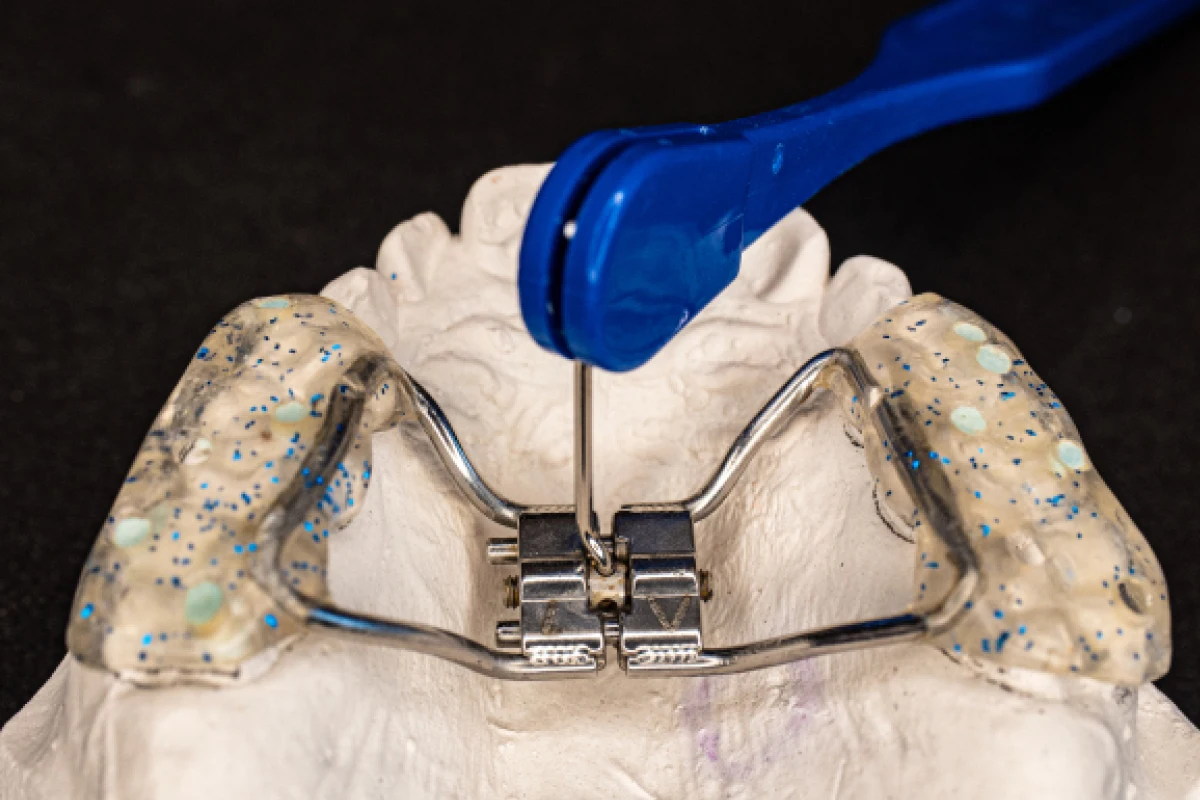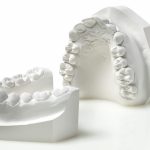
The AAO (American Association of Orthodontists) recommends having the first orthodontic visit no later than 7 years of age. (1) Waiting any longer could be a mistake since some problems are easily correctable if diagnosed early.
Early interceptive treatment can correct some malocclusions which, once growth has completed, are more difficult to deal with. (1)
There are some signs that can alarm parents and that deserve in-depth orthodontic attention, such as early or late loss of deciduous teeth, difficulty biting or chewing, mouth breathing, thumb sucking, significant dental crowding, etc. (1)
Interceptive treatment can:
- Guide maxillomandibular growth;
- Reduce the risk of trauma resulting from protrusion of the incisors;
- Correct any bad habits;
- Guide the permanent teeth into a more favourable position;
- Improve lip competence. (1)
Although most orthodontic treatments are performed between the ages of 9 and 14, some children may benefit from an earlier approach.
The advantages of early interceptive treatment
Over the years, research has shown that some malocclusions can benefit from early interceptive treatment, making later treatment easier – and in some cases even unnecessary. (2)
Postponing the treatment in a single phase to a more adult age and therefore leaving the child with a malocclusion could also have a possible psychological and social effect on his or her quality of life. (3)
Early treatment should:
- Make a possible second phase easier;
- Improve the psychological/social aspect of the child and his or her self-esteem;
- Reduce the possibility that extractions will be necessary in the future;
- Exploit the available growth without unnecessarily compromising the young patient’s cooperation and the family’s financial resources – always with a view to offering the most effective and efficient therapy.
There is a gap between what is demonstrated in the literature and what can be observed clinically regarding the need for early intervention.
Based on current evidence, the clinician will have to modify his or her treatment depending on the individual case, considering all available variables.
Interceptive orthodontics: when is it indicated?
Over time, the literature has demonstrated with a certain degree of evidence that early interceptive orthodontic treatment is electively indicated in cases of crossbite and class III bite. (2)
Early correction of this type of malocclusion avoids the complex sequelae that could occur in the future, without any intervention. With this approach, abnormal growth can be normalized with a good degree of stability over time.
For other common cases such as class II bites, open bites, or dento-skeletal discrepancies, the matter is more complex and there is no scientific evidence indicating that an interceptive approach would offer advantages. In these cases it is the clinician’s experience that orients the therapeutic plan in one direction or another.
Let’s take a look at the individual cases deserving consideration in the context of interceptive orthodontic treatment.
Posterior crossbite
This is a very common problem in children, with a prevalence between 8% and 22%. (4)
It may have a multifactorial origin, however it can be found with a certain degree of contraction of the upper jaw. About 80% of cases of crossbite in mixed dentition are caused by a functional mandibular deviation. (5,6)
If left untreated, a posterior crossbite with functional mandibular deviation is unlikely to self-correct, often also affecting the permanent dentition. This type of deviated and asymmetric growth can stabilize, resulting in a certain degree of skeletal asymmetry in the subject at the end of growth.
In these subjects, interceptive treatment is indicated as early as possible. (7,8)
Class III bites
When treating class III bites, it is necessary to perform an accurate diagnosis based on cephalometry and the subject’s family history, as well as on dental reports.
Skeletal class III bites, considering the mandibular growth pattern, will normally tend to worsen during adolescence (2). Furthermore, it should be considered that the forward and downward growth of the maxilla is completed quite early compared to other structures (9,10).
About 60% of class III bites are caused by a maxillary deficiency, which on average is contracted and retruded in an antero-posterior direction. (11)
It is therefore clear how, for class III bites supported by a deficit of the maxilla, immediate early treatment by protraction of the maxilla using a face mask is indicated.
The earlier treatment is started, the more effective it is, as the full growth potential of the jaw is exploited.
Class II bites
In this case, there is still a gap between clinical reality and scientific evidence.
In fact, although no scientific evidence has emerged that justifies an early interceptive treatment for class II bites – since the results would be comparable to those obtainable with a single, later phase treatment – it is still a much debated topic and there is certainly no consensus among clinicians. (12)
The only justification for early treatment may be reduction of the possibility of trauma to the upper incisors and greater patient self-esteem. (13)
The sagittal problem is often the expression of a transversal problem; while correcting the transversal problem one can also improve the class II bite while still preserving the patient’s cooperation, which will be essential near the growth peak, i.e. the right timing for the correction of class II bites.
That said, in itself, a class II bite does not represent an indication for early interceptive treatment.
Open bite
An open bite is often accompanied by a transverse contraction and bad habits such as tongue interposition, labial incompetence, and sucking. (14)
When the open bite does not have skeletal support (hyperdivergence), it will be sufficient to implement a therapy to normalize maxillary contraction (if present) along with a behavioural/speech therapy/myofunctional therapy to correct the bad habit.
Dentobasal discrepancies
For this type of problem it is difficult to find a common indication, but it is vital to evaluate the individual case carefully, taking into account the strengths and weaknesses of possible early intervention, or deciding to wait and treat the malocclusion at a later time.
References
- https://www.aaoinfo.org/public/uploads/2018/07/Your_Childs_First_Checkup-15-cons-hl.pdf
- Schneider-Moser, U.E., & Moser, L. (2022). Very early orthodontic treatment: when, why and how?. Dental Press Journal of Orthodontics, 27, e22spe2.
- Artese, F. (2019). A broader look at Interceptive Orthodontics: What can we offer?. Dental Press Journal of Orthodontics, 24, 7-8.
- Da Silva Filho, O. G., Santamaria Jr, M., & Filho, L. C. (2007). Epidemiology of posterior crossbite in the primary dentition. Journal of Clinical Pediatric Dentistry, 32 (1), 73-78.
- Kutin, G., & Hawes, R. R. (1969). Posterior cross-bites in the deciduous and mixed dentitions. American Journal of Orthodontics, 56 (5), 491-504.
- Clifford, F. O. (1971). Cross-bite correction in the deciduous dentition: principles and procedures. American Journal of Orthodontics, 59 (4), 343-349.
- Harrison, J. E., & Ashby, D. (2001). Orthodontic treatment for posterior crossbites. The Cochrane database of systematic reviews, (1), CD000979-CD000979.
- Lippold, C., Stamm, T., Meyer, U., Végh, A., Moiseenko, T., & Danesh, G. (2013). Early treatment of posterior crossbite-a randomised clinical trial. Trials, 14, 1-10.
- Ochoa, B. K., & Nanda, R. S. (2004). Comparison of maxillary and mandibular growth. American Journal of Orthodontics and Dentofacial Orthopedics, 125(2), 148-159.
- Laowansiri, U., Behrents, R. G., Araujo, E., Oliver, D. R., & Buschang, P. H. (2013). Maxillary growth and maturation during infancy and early childhood. The Angle Orthodontist, 83(4), 563-571.
- Guyer, E. C., Ellis III, E. E., McNamara Jr, J. A., & Behrents, R. G. (1986). Components of Class III malocclusion in juveniles and adolescents. The Angle Orthodontist, 56(1), 7-30.
- O’Brien, K., Wright, J., Conboy, F., Sanjie, Y., Mandall, N., Chadwick, S., & Shaw, I. (2003). Effectiveness of early orthodontic treatment with the Twin-block appliance: a multicenter, randomized, controlled trial. Part 1: dental and skeletal effects. American Journal of Orthodontics and Dentofacial Orthopedics, 124(3), 234-243.
- Ren, Y. (2004). Very few indications justify early treatment for severe Class II malocclusions. Evidence-Based Dentistry, 5 (4), 100-101.
- Ngan, P., & Fields, H. W. (1997). Open bite: a review of etiology and management. Pediatric Dentistry, 19(2), 91-98.
Would you like more information about Zhermack Dental products and solutions?
Contact us




 Zhermack SpA has been one of the most important producers and international distributors of alginates, gypsums and silicone compounds for the dental sector for over 40 years. It has also developed solutions for the industrial and wellbeing sectors.
Zhermack SpA - Via Bovazecchino, 100 - 45021 Badia Polesine (RO), Italy.
Zhermack SpA has been one of the most important producers and international distributors of alginates, gypsums and silicone compounds for the dental sector for over 40 years. It has also developed solutions for the industrial and wellbeing sectors.
Zhermack SpA - Via Bovazecchino, 100 - 45021 Badia Polesine (RO), Italy.


